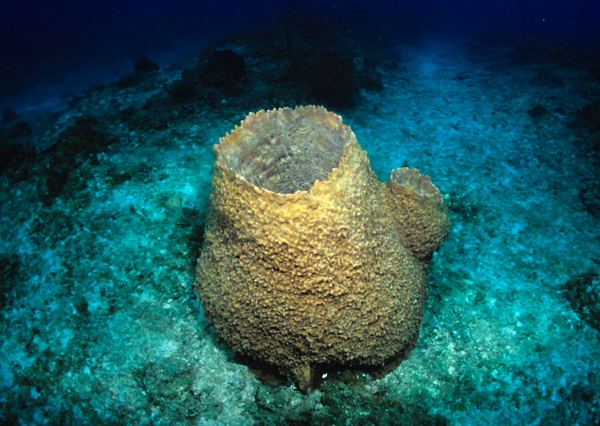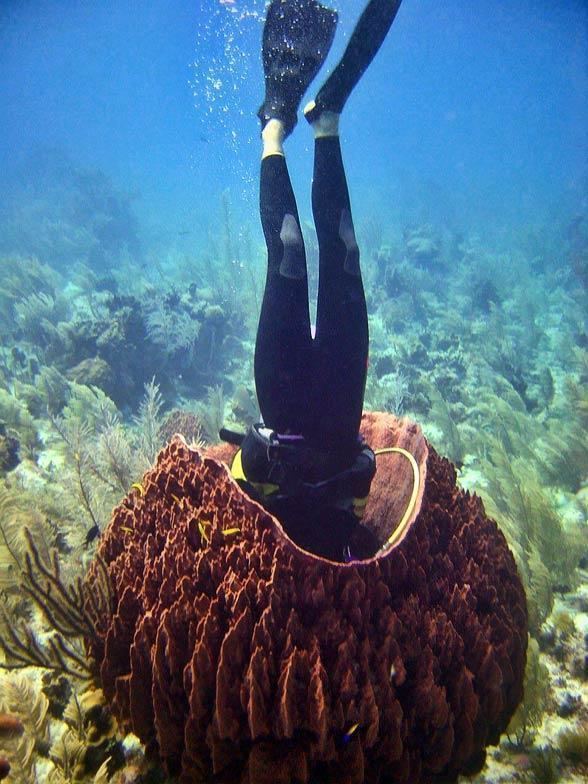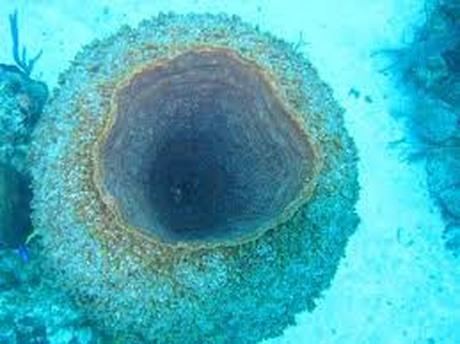Rank Species | Scientific name Xestospongia muta Higher classification Xestospongia | |
Similar Sponge, Xestospongia, Xestospongia testudinaria, Demosponge, Callyspongia | ||
Giant barrel sponges loom over a bahama reef science news
The giant barrel sponge (Xestospongia muta) is the largest species of sponge found growing on Caribbean coral reefs. It is common at depths greater than 10 metres (33 ft) down to 120 metres (390 ft) and can reach a diameter of 1.8 metres (6 feet). It is typically brownish-red to brownish-gray in color, with a hard or stony texture. The giant barrel sponge has been called the "redwood of the reef" because of its size and estimated lifespan of hundreds to a thousand or more years. It is perhaps the best-studied species of sponge in the sea; a population on Conch Reef, in the Florida Keys, has been monitored and studied since 1997.
Contents
- Giant barrel sponges loom over a bahama reef science news
- Giant barrel sponge filters fluorescent marker
- Description
- Distribution habitat and climate needs
- Biology
- Ecology
- References

Giant barrel sponge filters fluorescent marker
Description

The giant barrel sponge is variable in form. It is vary large and firm. Typically it is barrel-shaped, with a cone-shaped cavity at the apex known as the osculum. However, some individuals within the same population may be low and squat or relatively tall and thin. Similarly, the surface can range from smooth to rough, rugged, and irregular, sometimes with buttresses. In shallow water the color is brownish-red to brownish-gray, but at greater depths and in caves and under-hangs, or when the sponge is undergoing cyclic bleaching events, the sponge is pinkish or white.
Distribution, habitat, and climate needs

The giant barrel sponge is common on reefs throughout the Caribbean Sea, the Bahamas, Bermuda and the reefs and hard-bottom areas of Florida and the Gulf of Mexico. In terms of benthic surface coverage, it is the second most abundant sponge on reefs in the Caribbean region. On the reefs off the Florida Keys, it may be as common at two individuals per square metre (yard), and the total biomass of the sponge is greater than any other benthic invertebrate. The sponge grows on any hard surface; the smallest individuals observed are about 1 cm. Two or more closely related species that are visually indistinguishable from X. muta are found on reefs in the Pacific and Indian Oceans (particularly Xestospongia testudinaria).
Biology

The giant barrel sponge is a filter feeder. Water is continually pumped into the sides of the sponge, through the sponge body. and out the osculum at the top of the sponge. Small pores in the sponge body are connected to channels lined by collar cells, each with a flagellum, and the beating of these flagellae draws water through the channels. Incoming particles, particularly microscopic bacteria and prochlorophytes, are phagocytosed by the collar cells. Sponges like X. muta also absorb dissolved organic compounds directly from the seawater as part of their diet.

The giant barrel sponge is probably dioecious, and spawns its eggs or sperm directly into the water column. Clouds of sperm from males are emitted from the osculum, while females produce flocculent masses of eggs that are slightly negatively buoyant. Spawning can occur at any time of the year, and occurs patchily on the reef, but usually with many individuals participating at the same time. Fertilization occurs in the water column. Resulting sponge larvae disperse with ocean currents, but there is some genetic differentiation among populations from Florida, the Bahamas and Belize.
Growth models for X. muta have been formulated from digital photographs of the same sponges over a period of 4.5 years. Sponge growth rates ranged from over 400% per year to only 2% per year. The largest sponges on Conch Reef, about the size of an oil barrel, were estimated to be about 130 years old. The largest individual for which a photograph was available (now dead) was estimated to be 2300 years old. By using the growth model, the age of an individual X. muta can be estimated from the osculum diameter and the base circumference.
Ecology
The tissues of the giant barrel sponge contain photosynthetic symbiotic cyanobacteria which give the sponge its color. Individuals may undergo periodic bleaching, but this is a cyclic event, and the sponge recovers its normal coloration over time. Unlike the circumstances for coral bleaching, X. muta does not appear to rely on its photosynthetic symbionts for nutrition, and they are considered commensals. Unrelated to cyclic bleaching is a pathogenic condition of X. muta called "sponge orange band" that can result in the death of the sponge. The cause and transmission of this pathogenic condition remains a mystery.
The giant barrel sponge is an important member of the reef community. It serves as a habitat for various invertebrates which live on the surface or in the interior and is grazed upon by some parrotfishes. It is also host to a diverse community of microbes, some of which are primary producers or involved in nitrification.
